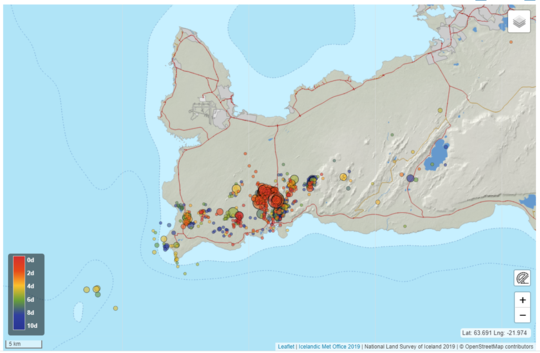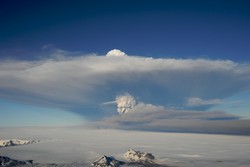Evidences that Grímsvötn volcano is getting ready for the next eruption
The Scientific Advisory Board met last week to review the current volcanic unrest at Reykjanes and to report on the latest measurements done at Grímsvötn volcano
The Scientific Advisory Board met last Wednesday, 10 June, to review the on-going volcanic unrest at Reykjanes and to discuss the latest measurements done at Grímsvötn volcano. The meeting was attended by scientists from the Icelandic Meteorological Office, University of Iceland – Institute of Earth Sciences, HS-Orka, Iceland Geosurvey and the Environmental Agency of Iceland. Representatives from the Civil Protection, ISAVIA-ANS and Police Dept. of the South-Iceland also participated.
An inflation started again close to Grindavík
In mid-May deformation data (GPS and InSAR measurements) started to show again signs of inflation, suggesting that a third intrusion since the beginning of this year is occurring west of Thorbjörn. The intrusion began around mid of May but the seismic activity started to increase toward the end of the month (30 May). About 2000 earthquakes have been detected since then and several events are located East of Thorbjörn, few kilometers North of the town of Grindavík. The largest earthquake of this swarm occurred on Saturday 13 June and had a magnitude of 3.5.

Overview of the seismicity around Grindavík since Friday last week. The M3.5 earthquake was detected on Saturday 13 June.
Since the beginning of the volcanic unrest, in January this year, the total uplift measured in the area is assessed to be around 12 cm. Between the inflation periods, slight deflation has been observed, probably reflecting the cooling of the intruded magma or the interaction with the geothermal system. Numerical modelling results show that this third intrusion is occurring roughly in the same area as the previous ones, i.e. at about 1 km West of Thorbjörn, at a depth of 3-4 km, with a width of few hundreds of meters and oriented NE-SW for about 6 km. The estimated median volume of magma accumulated during this third intrusion episode is estimated to be 1.2 million m3. The seismic activity is occurring over an area larger than the extension of the intrusion itself and this is probably due to the stress change induced to the crust which affects a wider sector of the peninsula.
Iceland Geosurvey performed micro-gravity measurements along some profiles in late January when the intrusion started near Thorbjörn and they repeated the measurements in late April. The results confirm the presence of intruded magma at depth. Therefore there is a reason to repeat the measurements again and it will be done in mid-summer.
Weekly gas measurements at two sites near the area of the intrusion changes occasionally over time but the interpretation is still unclear. No chemical changes have been detected at the geothermal power plant in Svartsengi. However, measurements of the geothermal system reveal an increased permeability and increased fluid flow in the surrounding rock, which can be linked to the earthquake activity, inflation and uplift in the area, which triggered the creation of new cracks and opening of older ones. Processing of seismic data at the IMO suggests that permanent changes have occurred in the crust nearby Grindavík since the new year.
The Icelandic Meteorological Office, together with the Institute of Earth Sciences, Iceland Geosurvey and HS-Orka will continue to monitor closely the developments in the Reykjanes peninsula.
Evidences that Grímsvötn volcano is getting ready for the next eruption
At the SAB meeting the status of Grímsvötn volcano was also discussed, as the Earth Science Institute and the Icelandic Meteorological Office had new measurements performed in the beginning of June.
During its active period, as it is
since the eruption in 1996, Grímsvötn erupts on average each 5-10 years. The
last eruption occurred in 2011 and it was a fairly large and powerful event.
Between eruptions, the deformation data indicate the gradual accumulation of
new magma at depth and the increased pressure in the system. In the last weeks
scientists from the IMO measured SO2 in the southwest corner of the
caldera in Grímsvötn, close to where the last eruptions in 2004 and 2011 took
place. “This is the first time that we measure so much SO2 at a
volcano in Iceland that is not in an eruptive phase and its presence is
indicative of magma at shallow level”, says Melissa Anne Pfeffer, specialist at
the IMO who participated in the trip on Vatnajökull in these last days. In
addition to the high level of SO2, Melissa reports also that the
area where geothermal activity can be detected at the surface of the volcano
has notably increased.

Specialist of the Icelandic Meteorological Office performing gas measurements in Grímsvötn in the recent days. This picture is taken nearby the place where the last eruption in 2011 took place. (Photo: IMO/Melissa Anne Pfeffer)
In 1953, Sigurður Þórarinsson suggested a correlation between jökulhlaup (glacial floods) and eruptions in Grímsvötn. When the pressure in the volcanic system is increased due to magma accumulation and if a large volume of water is stored in the lake, the pressure release following the removal of water during a flood could facilitate the magma rising to the surface and trigger, in this way, an eruption. This kind of scenario has occurred several times in Grímsvötn, the last time in 2004, but also in 1934 and 1922.
Chances of an eruption starting at the end of a glacial flood (jökulhlaups)
The current conditions of Grímsvötn volcano are such that the water level is rather high and the pressure in the magma chamber below the caldera has reached values comparable to those prior to the last eruption. Therefore, the possibility of an eruption triggered by a glacial flood, which could occur in the coming weeks or months, has to be considered. However, this may not be the case, and the next glacial flood may not lead to an eruption.
To discuss further the current status of Grimsvötn volcano and the latest observations, the Scientific Advisory Board will meet again on June 18.




